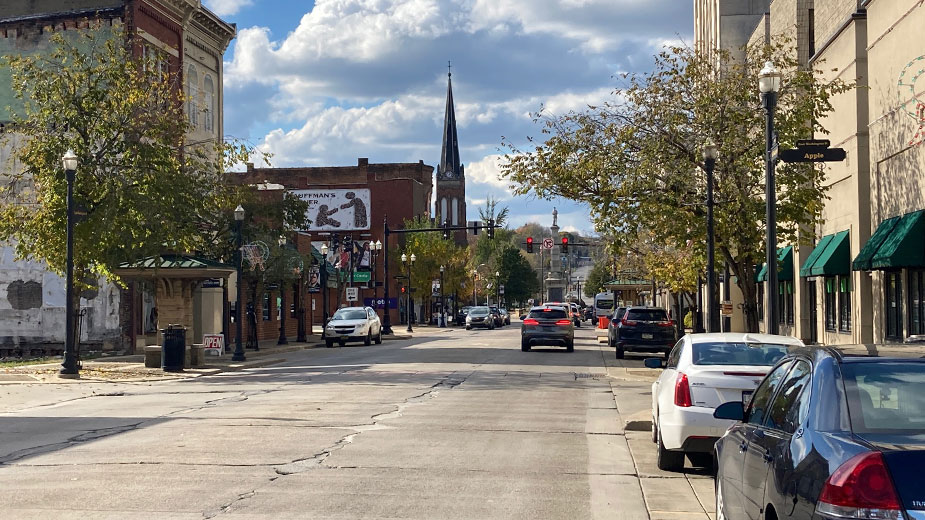NEW CASTLE, Pa. – The Lawrence County Regional Chamber of Commerce will receive the final report and recommendations of its Forward Lawrence initiative on Dec. 1.
The chamber and its sister entities, Lawrence County Regional Chamber Foundation and Lawrence County Economic Development Corp., began the effort to craft a countywide economic and community development plan about two years ago.
Last year, the agencies received $125,000 in funding from the Appalachian Regional Commission and U.S. Department of Agriculture and raised $60,000 more to fund the initiative, says Alex McCoy, CEO of the Lawrence County Regional Chamber.
Using the funds, the chamber engaged two consulting firms: Garner Economics LLC of Atlanta and Development Counsellors International of New York. The firms have produced a “competitive realities” report that offers a demographic overview and comparison to community perceptions, a proposed marketing strategy and, more recently, a draft economic development action plan.
Jay Garner, Garner Economics president and founder, has spearheaded economic development for such communities as Tampa, Fla.; Chattanooga, Tenn.; Mobile, Ala.; and Ashville, N.C., according to McCoy.
“He certainly knows what he’s talking about,” McCoy says. “He’s pointing us in the right direction with regard to his recommendations.”
The draft Forward Lawrence plan is being reviewed by the chamber steering committee and some 250 community stakeholders. It was recently discussed during three public feedback sessions.
The proposal identifies four core business sector targets – defined as Industry 4.0, agribusiness and small-scale food processing, distribution and supply chain and entrepreneurial development – along with a fifth centered on the “experiential economy,” or tourism.
“A lot of what Garner is recommending makes sense for us,” McCoy says. Lawrence County is in a region with a “very long and proud manufacturing history.”
Looking at distribution and logistics opportunities, there is a “tremendous density” of interstate highways, which is at “the epicenter of an overwhelming majority” of the population.
Recommendations in the draft plan include exploring a business incubator-accelerator or some sort of maker space, a concept that has support from the steering committee, McCoy says. If the recommendation is included in the final plan, the chamber might go back to ARC and USDA, which funded the Forward Lawrence effort, and possibly the U.S. Economic Development Administration to request money for a feasibility study.
An emphasis on the experiential economy, or tourism, is in line with the thinking of many millennials and members of Generation Z, who “don’t seem to want to necessarily spend their money on the acquisition of things as much as they do on acquiring memories,” McCoy says.
Capitalizing on that will require a strong partnership with the local tourism promotion agency, Visit Lawrence County, McCoy says. He looks forward to discussions with the agency’s executive director, Janet Falotico, “about how we can help her better promote our area and its uniqueness outside our community,” he says.
McCoy says he’s looking to the plan to inform the chamber’s next program of work. Aspects of the recommendations that other entities take on could create opportunities for “strategic alliances where we can use the limited resources of the community to better create value and better position us for future growth and development.”
Linda Nitch, chamber director of economic development, expects the final report to recommend a more targeted approach to economic development. “It has been difficult with that broader approach to really identify sector industries that could thrive here,” she says.
The community input process has been positive overall, says Melanie DeVincentis, chamber communications and investor experience specialist. Feedback sessions have centered on next steps, hoped-for outcomes and “constructive talk about implementing the recommendations and finding our community champions for those recommendations,” she says.
The first of the three community input sessions took the entire hour. About three-fourths of that time was spent by people sharing their ideas about how to implement the recommendations, indicating “good community buy-in,” McCoy says.
“At the end of the day, the community has to buy into the process. We could come up with the best plan in the world. But if people don’t feel a part of it or they’re not going to support it, there’s no future for it,” he says.
Pictured: Downtown New Castle.
